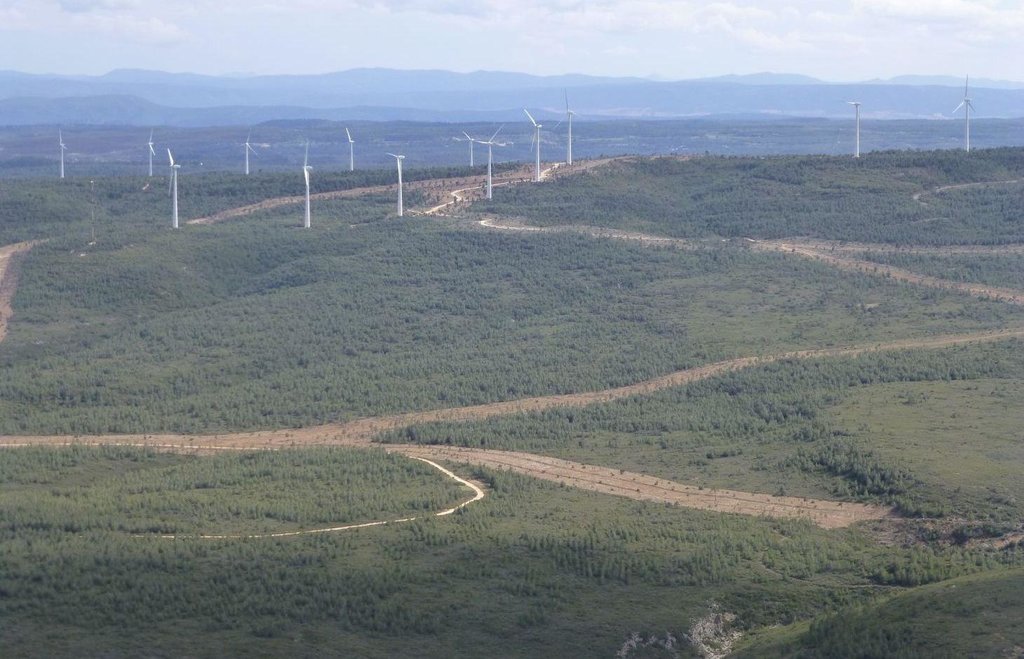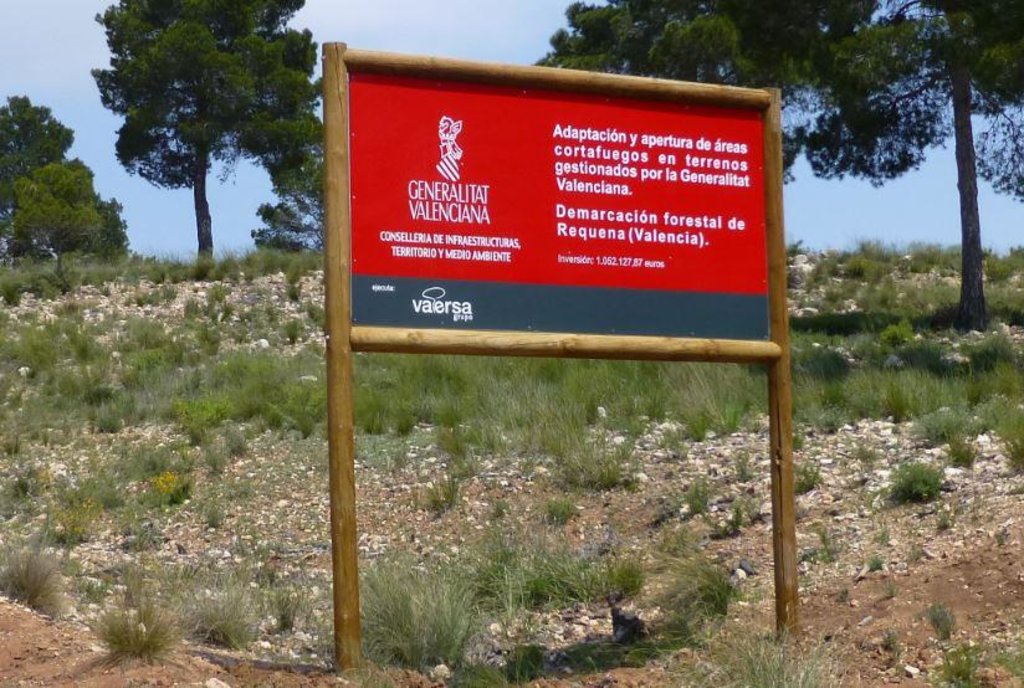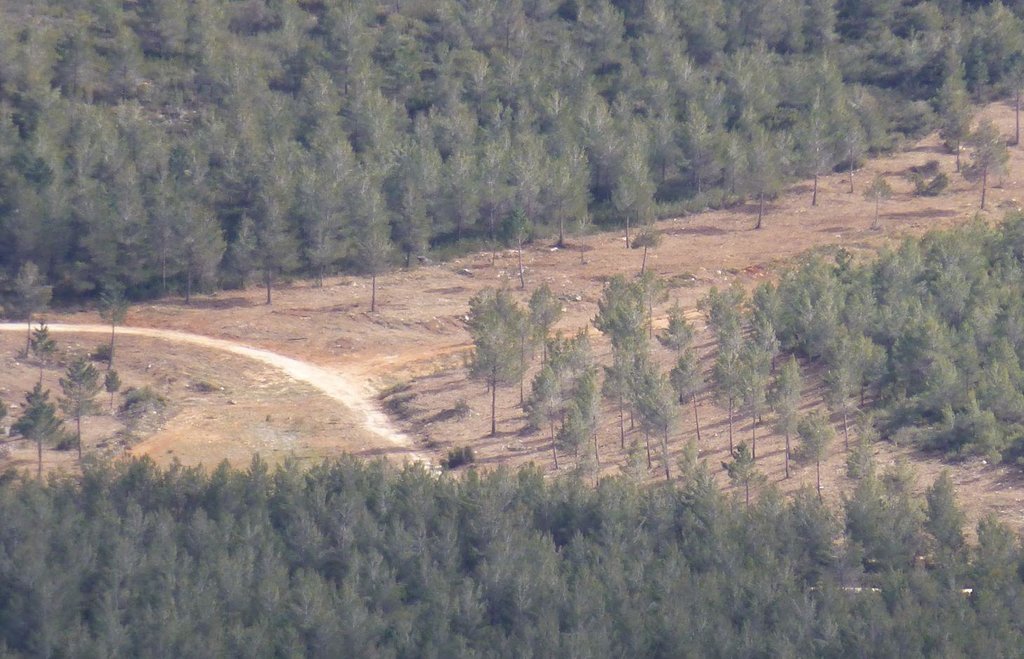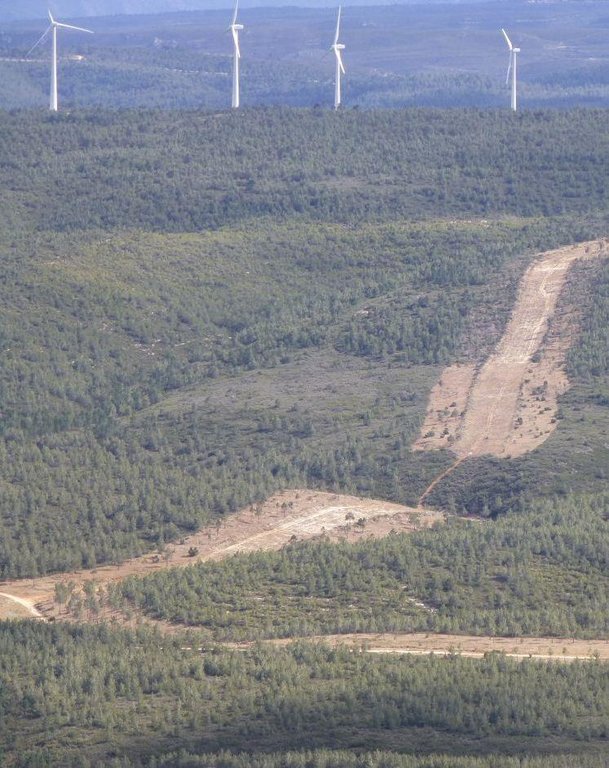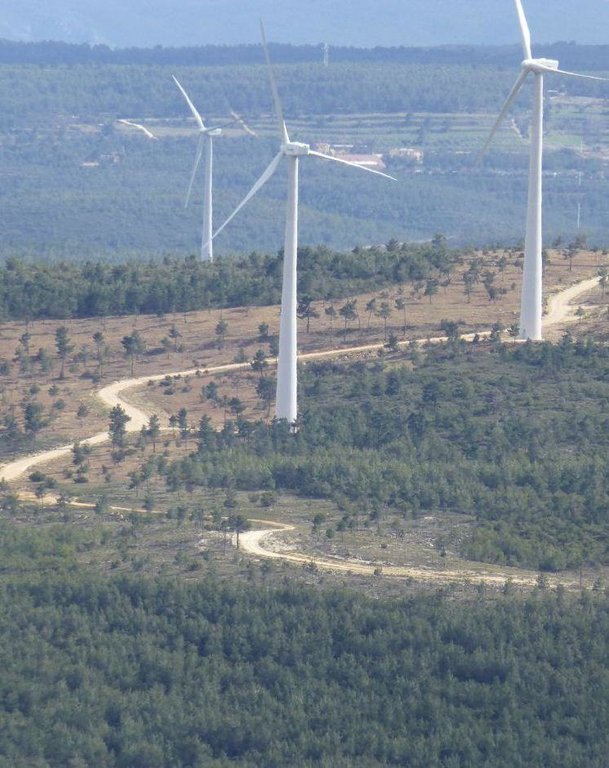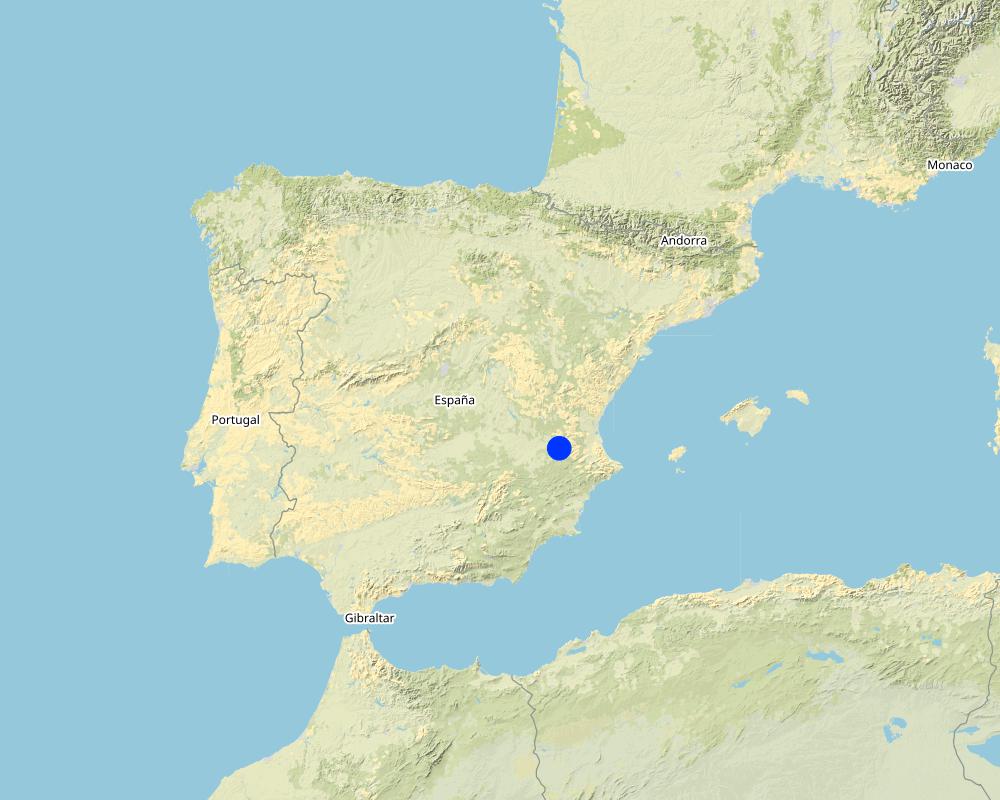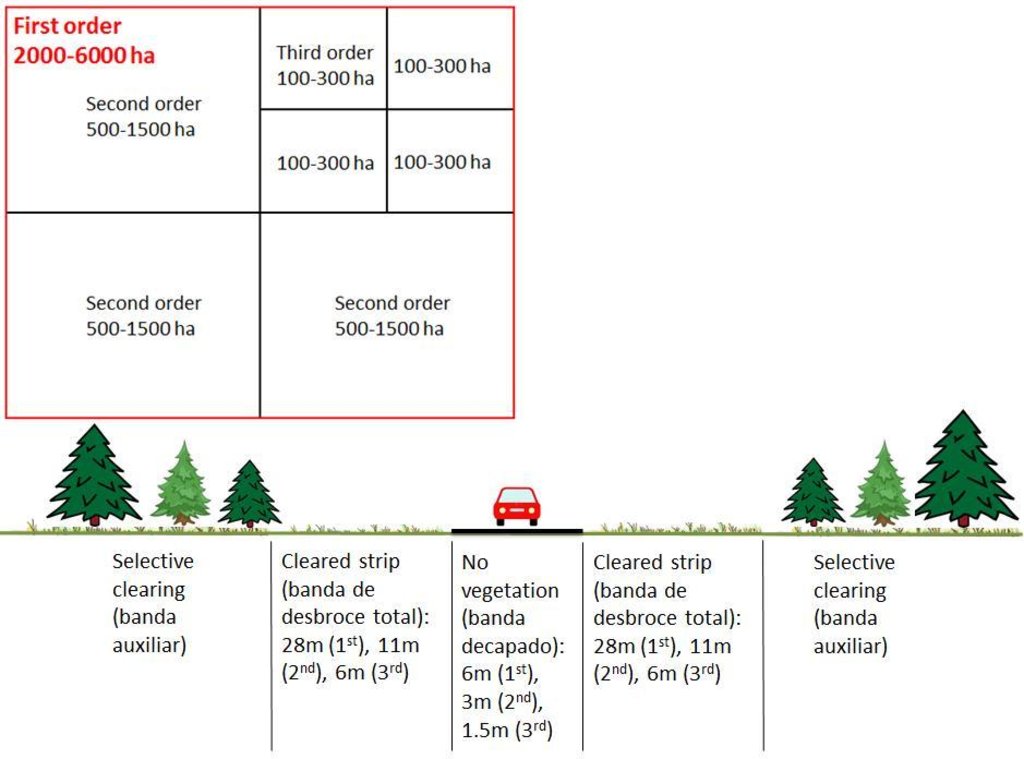Cleared strip network for fire prevention (firebreaks) [西班牙]
- 创建:
- 更新:
- 编制者: Nina Lauterburg
- 编辑者: –
- 审查者: Alexandra Gavilano, Nina Lauterburg, Deborah Niggli, Hanspeter Liniger
Área cortafuegos
technologies_1592 - 西班牙
- Cleared strip network for fire prevention (firebreaks): Jan. 3, 2017 (inactive)
- Cleared strip network for fire prevention (firebreaks): March 15, 2017 (inactive)
- Cleared strip network for fire prevention (firebreaks): July 31, 2019 (inactive)
- Cleared strip network for fire prevention (firebreaks): Dec. 1, 2021 (public)
查看章节
全部展开 全部收起1. 一般信息
1.2 参与该技术评估和文件编制的资源人员和机构的联系方式
有助于对技术进行记录/评估的项目名称(如相关)
Catastrophic shifts in drylands (EU-CASCADE)有助于对技术进行记录/评估的机构名称(如相关)
Centro de Estudios Ambientales del Mediterraneo (CEAM) - 西班牙1.3 关于使用通过WOCAT记录的数据的条件
编制者和关键资源人员接受有关使用通过WOCAT记录数据的条件。:
是
1.4 所述技术的可持续性声明
这里所描述的技术在土地退化方面是否存在问题,导致无法被认为是一种可持续的土地管理技术?:
否
1.5 参考关于SLM方法(使用WOCAT记录的SLM方法)的调查问卷
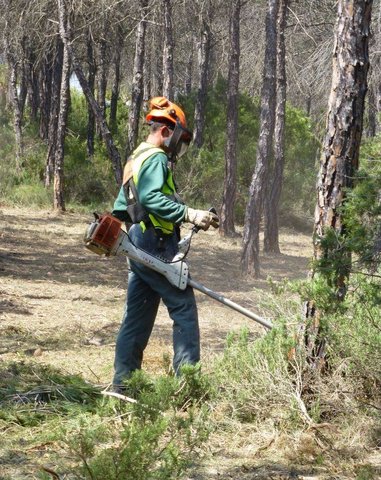
Plan of preventive silviculture (PSP): implementation of firebreak … [西班牙]
Through the declaration of Ayora to a forest intervention area (ZAU) and the implementation of the pilot project of the PSP, a preventive silviculture was promoted through the establishment of a firebreak network.
- 编制者: Nina Lauterburg
2. SLM技术的说明
2.1 技术简介
技术定义:
The basic principle of a firebreak network is to split continuous forest areas (where a lot of fuel is built up) into smaller patches separated by vegetation-free strips in order to prevent large forest fires.
2.2 技术的详细说明
说明:
In the forest law 3/1993 the declaration of special areas to “Zonas de Actuación Urgente (ZAU)” (zone of urgent actions) through the regional government of Valencia is defined. Objectives are the protection against natural hazards and the promotion of forest restoration within this area. Ayora was declared to a ZAU in 1997 due to its high risk of fires. In the “Plan de Selvicultura Preventiva de Incendios en los Sistemas Forestales de la Comunidad Valenciana” which became operative in 1996 and whose main objective is the reduction of the fire risk, the ZAU is practically addressed for the first time in the establishment of firebreaks (áreas cortafuegos). Based on this plan, the firebreaks were established within a pilot project “Proyecto Piloto de Selvicultura Preventiva” between 1998 and 2002, carried out by the company VAERSA (public company of the Generalitat Valenciana).
A firebreak is a strategically located strip on which the vegetation cover has been partially or totally removed down to mineral soil with the aim of controlling the spread of large forest fires. The main purposes are 1) to interrupt the continuity of hazardous fuels across a landscape to decrease the area affected by fires, 2) to provide areas where fire fighters are protected and can work more efficiently, 3) to slow down a fire, to reduce the fire intensity and caused damages, and 4) to provide strips where fuel management is facilitated. The total surface protected by the firebreaks is 33’851 ha while the management measures are executed on 1944,81 ha. This technology is also applied in other countries, e.g. Portugal, South Carolina or South Africa.
The establishment and maintenance are labour-intensive and expensive. Firebreaks can range between a protected area of 2000-6000 ha (first order), 500-1500 ha (second order), and 100-300 ha (third order), together forming a system isolating separate areas by wide strips. This parcelling aims in limiting the burnt area to a maximum of 6000 ha. Each firebreak consists of a bare vegetation-free strip (banda decapado). The width of the bare area ranges between 6m (first order), 3m (second order) and 1.5m (third order). Existing vegetation-free areas (e.g. roads) are used to establish firebreaks to have less visual impact. If there is no road, trees and shrubs have to be cleared and chipped entirely using chainsaws and special tractors. On each side of the bare area there is a totally cleared strip (banda de desbroce total). The width depends on the climatic zone, the order and the hazard of fuel, therefore ranging between 28m (first order), 11m (second order) and 6m (third order). Almost all the existing vegetation is cleared, only some isolated mature trees are not cut if they do not contribute to the propagation of a fire. On both sides of these strips there are auxiliary strips (banda auxiliar) where selective clearing is applied until reaching a desired density. Sick trees are cleared with priority. Species of high ecologic value and low flammability level are not cleared, such as Juniperus phoenicea, Juniperus oxycedrus and Quercus ilex ssp. rotundifolia. The width of these elements can vary according to the prevalent conditions. A part of the wood generated by the clearings is used as fuelwood, the other part is chipped and distributed on the soil as mulch. Firebreaks are often located on mountain ridges and created with 45° to the dominant wind direction (west) to facilitate fire extinction.
The maintenance of firebreaks is extremely important. Without clearing, fire-prone species will encroach which decreases the effectiveness of the firebreak. The maintenance is realized depending on the vegetation, usually in firebreaks of first order the maintenance is done every 2 years (“decapado” and “desbroce total”) or every 4 years (“banda auxiliar”) while firebreaks of second and third order are cleared every 4 years. In the here described project the maintenance was carried out in three phases (2001-2004, 2004-2008 and 2008-2012).
The region of Ayora is mountainous with a dry subhumid climate (~380 mm annual rainfall). The risk of fire incidence is at its highest from June to September when there are adverse conditions like drought, high temperatures and strong winds (mainly the winds coming from central Spain, called “poniente”). The population density is very low and there are only few job opportunities (e.g. marginal agriculture, grazing, hunting, beekeeping, artisanry, wind mill parc). Most of the inhabitants work in the nuclear power plant. Forest management could be a source for jobs.
2.3 技术照片
2.5 已应用该技术的、本评估所涵盖的国家/地区/地点
国家:
西班牙
区域/州/省:
Spain, Valencia
有关地点的进一步说明:
Region of Ayora (including the municipalities Requena, Cofrentes, Jalance, Jarafuel, Zarra, Ayora)
具体说明该技术的分布:
- 均匀地分布在一个区域
如果不知道精确的区域,请注明大致覆盖的区域:
- 100-1,000 平方千米
注释:
Boundary points of the Technology area: The above indicated coordinates only show one firebreak (first order). But there is a whole system of firebreaks which is visible in the Google Earth file.
Map
×2.6 实施日期
如果不知道确切的年份,请说明大概的日期:
- 10-50年前
2.7 技术介绍
详细说明该技术是如何引入的:
- 通过项目/外部干预
注释(项目类型等):
In the past, farmers built small firebreaks on their own. When the forest law (ley forestal 3/1993) became effective in the year 1993 the construction of big firebreaks became mandatory. The firebreaks which are documented here were established within a pilot project carried out in the ZAU Ayora (zona de actuación urgente, zone of urgent actions) between 1998 and 2002.
3. SLM技术的分类
3.1 该技术的主要目的
- 降低灾害风险
3.2 应用该技术的当前土地利用类型

森林/林地
产品和服务:
- 木材
- 薪材
- 水果和坚果
- 其它森林产品
- 放牧/啃牧
- 自然保持/保护
- 娱乐/旅游
- 自然灾害防护
- wind mill parc, hunting
注释:
Major land use problems (compiler’s opinion): In Ayora, the prevalent dense shrublands (dominated by seeder species), which resulted from past agricultural land use (changes of the vegetation composition, e.g. removal of key species), land abandonment/rural depopulation and fire occurrence, contain a high fire risk because of both the high fuel loads and their continuity. Also dense forests (either afforestations or natural regeneration) show a high risk for fires. Through the modifications of the vegetation composition in the past (removal of more fire resistant resprouter species (mature forest), whereas fire-prone seeder species are now spreading), the resilience of the ecosystem to fires has decreased. Today a higher fire recurrence can be observed which could still be worsen by future climate change impacts, undermining more and more the ecosystem’s capacity to buffer such shocks. Before the implementation of firebreaks, it was almost impossible to stop a fire and it was much more dangerous for fire fighters. There was also no access for fire-fighting vehicles.
Selective felling of (semi-) natural forests: As a management practice. The forest should be cleared more frequently since there is a huge amount of fuel.
Clear felling of (semi-)natural forests: Within the firebreak
Plantation forestry: Almost the whole forest in this region was planted
Number of growing seasons per year:
1
3.5 该技术所属的SLM组
- 天然和半天然森林管理
3.6 包含该技术的可持续土地管理措施

植物措施
- V3:植被的清理
3.7 该技术强调的主要土地退化类型

生物性退化
- Bc:植被覆盖的减少
- Bf:火灾的有害影响
注释:
Main causes of degradation: deforestation / removal of natural vegetation (incl. forest fires) (Deforestation in the past (removal of resprouter species), land abandonment, uncontrolled growth of fire prone vegetation, afforestations, forest fires), population pressure (Vast areas were deforested in the past for agriculture, important key species were removed. After land abandonment there was a lack of management strategies), poverty / wealth (The current economic crisis in Spain leads to a lack of investment in forest management, therefore only a minor part of forests is managed (natural parks)), labour availability (In the past there was outmigration from the region to the big cities and therefore there was a lack of management)
Secondary causes of degradation: change of seasonal rainfall (More variability in precipitation leads to a higher risk of fires), droughts (more fires during droughts), land tenure (The state is only allowed to apply management practices in public forest. The private forest is often not managed which increases the risk of fires and the resulting degradation), inputs and infrastructure: (roads, markets, distribution of water points, other, …) (There were big fires in the past because of the lack of fire extinction media like water ponds, streets, transport media (this has been improved now)), education, access to knowledge and support services (Loss of knowledge, important for today’s fires: People (especially from the cities) are not aware anymore of the risk of fire. In the past people lived with the risk and knew how to prevent fires), governance / institutional (Law to induce implementation of conservation interventions (ley forestal 3/1993) and “plan de selvicultura preventiva de incendios en los sistemas forestales de Valencia (1996)”. Before less practices)
3.8 防止、减少或恢复土地退化
具体数量名该技术与土地退化有关的目标:
- 防止土地退化
4. 技术规范、实施活动、投入和成本
4.1 该技术的技术图纸
技术规范(与技术图纸相关):
Firebreaks can range between a protected area of 2000-6000 ha (first order), 500-1500 ha (second order), and 100-300 ha (third order), together forming a system isolating separate areas by wide strips. This parcelling aims in limiting the burnt area to a maximum of 6000 ha. Each firebreak consists of a bare strip (banda decapado) ranging between 6m (first order), 3m (second order) and 1.5m (third order). On both sides of the bare area there is a totally cleared strip (banda de desbroce total) whose width ranges between 28m (first order), 11m (second order) and 6m (third order). On both sides of these strips there are auxiliary strips (banda auxiliar) where selective clearing is applied. The width of these elements can vary according to the prevalent conditions.
Location: Ayora. Valencia, Spain
Date: 02-12-2013
Technical knowledge required for field staff / advisors: high (The forest agent needs a high technical knowledge. He acts as a link between engineer and forest brigade and controls if the brigade executes what the engineer dictates. He also provides assistance.)
Technical knowledge required for Engineer: high (The forest engineer works for the state and plans where to establish fire breaks and how to construct them (e.g. how much fuel to remove, which machines to use). He needs a high technical knowledge.)
Technical knowledge required for Forest brigade/workers: low (The forest workers only execute what the engineer and the forest agent tell them. They need to know how to handle the machines but don’t have to judge where and how to establish the firebreaks.)
Main technical functions: control of fires
Secondary technical functions: reduction of dry material (fuel for wildfires)
Vegetative measure: Clearing to establish strips free of vegetation
Vegetative material: T : trees / shrubs
Trees/ shrubs species: Trees and shrubs are cleared
作者:
Nina Lauterburg
4.2 有关投入和成本计算的一般信息
其它/国家货币(具体说明):
Euro
如相关,注明美元与当地货币的汇率(例如1美元=79.9巴西雷亚尔):1美元=:
0.74
注明雇用劳工的每日平均工资成本:
47.00
4.3 技术建立活动
| 活动 | 时间(季度) | |
|---|---|---|
| 1. | Project planning and design of firebreak system | 1996 |
| 2. | Adaption of the agricultural tractors with forest management machinery (wheels, protection of the machine against stones, clearing machinery with chains) | 1998-2002 |
| 3. | Cutting and chipping (in-situ) of trees and shrubs (execution of firebreak network) | 1998-2002 |
| 4. | Transport of wood (fuel wood) | 1998-2002 |
4.4 技术建立所需要的费用和投入
| 对投入进行具体说明 | 单位 | 数量 | 单位成本 | 每项投入的总成本 | 土地使用者承担的成本% | |
|---|---|---|---|---|---|---|
| 劳动力 | labour | ha | 1.0 | 1095.0 | 1095.0 | |
| 设备 | machine use | ha | 1.0 | 675.0 | 675.0 | |
| 技术建立所需总成本 | 1770.0 | |||||
| 技术建立总成本,美元 | 2391.89 | |||||
注释:
Duration of establishment phase: 36 month(s)
4.5 维护/经常性活动
| 活动 | 时间/频率 | |
|---|---|---|
| 1. | Clearing of firebreaks of first order (every 2 years) | every 2 years |
| 2. | Clearing of firebreaks of second and third order (every 4 years) | every 4 years |
4.6 维护/经常性活动所需要的费用和投入(每年)
| 对投入进行具体说明 | 单位 | 数量 | 单位成本 | 每项投入的总成本 | 土地使用者承担的成本% | |
|---|---|---|---|---|---|---|
| 设备 | machine use | ha | 1.0 | 557.0 | 557.0 | |
| 技术维护所需总成本 | 557.0 | |||||
| 技术维护总成本,美元 | 752.7 | |||||
注释:
The total costs of the firebreaks (establishment and maintenance) were calculated for the application of the technology on one hectare, based on the indications given in the official project documents of the regional government (Generalitat Valenciana) and information from different stakeholders (e.g. forest agent, university staff, employee of VAERSA). The whole project costs were around 3 Mio Euro for the establishment and around 1.5 Mio Euro for the maintenance phase. The maintenance costs refer to the third maintenance phase taking place from 2008 to 2012. The costs of the execution of the project were 1312 Euro/ha (1770 Dollar) and the costs of the maintenance were 82.03 Euro/ha (110 Dollar, after 2 years) and 331.37 Euro/ha (446 Dollar, after 4 years).
The currency rate (Euro-Dollar) was calculated on November 16th, 2013.
4.7 影响成本的最重要因素
描述影响成本的最决定性因素:
The costs of the establishment of firebreaks can be affected by numerous factors, such as slope (if the slope is steep, the work is much more difficult and takes more time, because machines cannot be used on steep slopes), vegetation density (it takes more time to clear a dense area), stone content of the soil (if there are many stones the work is much more difficult for the machines and more dangerous for the workers), availability of a road (where a firebreak can be established, costs can be saved). Important to note is that maintenance costs could increase with an increase in rainfall because the vegetation will grow faster (otherwise firebreaks are quite resistant against climate change or weather extremes). Furthermore, modifying a normal tractor for forest management can be extremely expensive.
5. 自然和人文环境
5.1 气候
年降雨量
- < 250毫米
- 251-500毫米
- 501-750毫米
- 751-1,000毫米
- 1,001-1,500毫米
- 1,501-2,000毫米
- 2,001-3,000毫米
- 3,001-4,000毫米
- > 4,000毫米
有关降雨的规范/注释:
Ayora (383mm)
农业气候带
- 半湿润
Thermal climate class: temperate
5.2 地形
平均坡度:
- 水平(0-2%)
- 缓降(3-5%)
- 平缓(6-10%)
- 滚坡(11-15%)
- 崎岖(16-30%)
- 陡峭(31-60%)
- 非常陡峭(>60%)
地形:
- 高原/平原
- 山脊
- 山坡
- 山地斜坡
- 麓坡
- 谷底
垂直分布带:
- 0-100 m a.s.l.
- 101-500 m a.s.l.
- 501-1,000 m a.s.l.
- 1,001-1,500 m a.s.l.
- 1,501-2,000 m a.s.l.
- 2,001-2,500 m a.s.l.
- 2,501-3,000 m a.s.l.
- 3,001-4,000 m a.s.l.
- > 4,000 m a.s.l.
5.3 土壤
平均土层深度:
- 非常浅(0-20厘米)
- 浅(21-50厘米)
- 中等深度(51-80厘米)
- 深(81-120厘米)
- 非常深(> 120厘米)
土壤质地(表土):
- 细粒/重质(粘土)
表土有机质:
- 低(<1%)
5.4 水资源可用性和质量
地下水位表:
5-50米
地表水的可用性:
匮乏/没有
水质(未处理):
良好饮用水
5.5 生物多样性
物种多样性:
- 中等
5.6 应用该技术的土地使用者的特征
生产系统的市场定位:
- 混合(生计/商业)
个人或集体:
- 员工(公司、政府)
性别:
- 男人
说明土地使用者的其他有关特征:
Land users applying the Technology are mainly common / average land users
Difference in the involvement of women and men: The work is mainly done by men, because it is heavy work and it is not usual that women are working in the forest.
Population density: < 10 persons/km2
Annual population growth: negative
Off-farm income specification: The forest brigade is only working when there is money and a project. If there is no money they have no work and need to have a look for another job.
5.8 土地所有权、土地使用权和水使用权
土地所有权:
- 州
- 个人,有命名
土地使用权:
- 个人
- open access but organised (e.g. wood, hunting)
- open access but organised (e.g. wood, hunting)
注释:
There is some public land, controlled by the state. But there is also some private land. The access to the public land is open but organized. Permission is needed from the government to cut trees, to build a house or to hunt. There are some private hunting areas for which the hunting association has to pay a fee.
6. 影响和结论性说明
6.1 该技术的现场影响
社会经济效应
生产
饲料生产
注释/具体说明:
Vegetation removal produces fresh growth. More grasses available for animals (game and livestock) in the cleared areas.
饲料质量
注释/具体说明:
The new growth provides more diverse and nutritious fodder. Animals (especially goats) eat everything but they like more young grasses than shrubs
畜牧生产
注释/具体说明:
Game/wildlife and livestock are better because there is an increase in fodder quantity and quality
木材生产
注释/具体说明:
The wood/timber generated by the clearing can be used for biomass, fertilizers, pellets, firewood. A part of the wood is chipped in-situ and applied as mulch
生产区域
注释/具体说明:
In some areas, the implementation of firebreaks can occupy productive land which means a loss of land. The main objective of this technology is to provide protection from forest fires instead of creating productive land
能源生产
注释/具体说明:
In some areas, the cleared ground on mountain ridges is used for wind mills. A part of the cleared vegetation is used for bioenergy (biomass).
收入和成本
农业投入费用
注释/具体说明:
The establishment and the maintenance of fire breaks is expensive.
其它社会经济效应
fuelwood
注释/具体说明:
Villagers of Jarafuel receive fuelwood gained by clearings for free (from municipal council).
job uncertainty
注释/具体说明:
If there is no money provided by the state the maintenance of fire breaks cannot be executed. This constitutes a high risk for forest workers because they never know if they will loose their job.
社会文化影响
食品安全/自给自足
注释/具体说明:
Forest workers earn money to buy food, otherwise they would depend on unemployment pay and thus put pressure on the state.
健康状况
注释/具体说明:
Improved air quality by reducing forest fires.
娱乐机会
注释/具体说明:
People often criticise the aesthetic impact of fire breaks. But this impact is smaller than if the whole forest is burnt
SLM/土地退化知识
注释/具体说明:
Local people know about the importance of conservation of the area and really like to have the forest protected of wildfires
冲突缓解
注释/具体说明:
Less fires result in a decrease of the destroyed area, less money will have to be invested in restoration or fire extinction. Farmers, hunters,honey producers will experience fewer losses. Wild animals remain in the forest (more grasses after clearing).
社会经济弱势群体的情况
注释/具体说明:
More jobs for unemployed, this is especially important during the current economic crisis
contribution to human well-being
注释/具体说明:
Through the establishment and the maintenance of firebreaks it is easier to control fires and protect people. Furthermore it created jobs for the unemployed. But it seems that in general forest management is not something people want to do, they work in this sector only if there are no other job opportunities. Forest management means a hard job and this kind of work is not well-respected in society
生态影响
水循环/径流
地表径流
注释/具体说明:
On the cleared strips, associated with the vegetation removal
土壤
土壤水分
注释/具体说明:
On the cleared strips, associated with the vegetation removal
土壤覆盖层
注释/具体说明:
On the cleared strips, but not too bad because of the mulch layer (removed vegetation is chipped in-situ)
土壤有机物/地下C
注释/具体说明:
On the cleared strips, associated with the vegetation removal
减少气候和灾害风险
碳和温室气体的排放
注释/具体说明:
If the fire is stopped more quickly there will be less emissions
火灾风险
注释/具体说明:
The firebreaks prevent the occurrence and spread of large forest fires by providing access for fire fighters
6.2 该技术的场外影响已经显现
下游洪水
注释/具体说明:
When fire removes less vegetation then the soil is less prone to flooding
下游淤积
注释/具体说明:
When fire removes less vegetation then the soil is less vulnerable to erosion
对邻近农田的破坏
对公共/私人基础设施的破坏
注释/具体说明:
Forest fire frequency and intensity and the associated damages are reduced
6.3 技术对渐变气候以及与气候相关的极端情况/灾害的暴露和敏感性(土地使用者认为的极端情况/灾害)
渐变气候
渐变气候
| 季节 | 增加或减少 | 该技术是如何应对的? | |
|---|---|---|---|
| 年温度 | 增加 | 好 |
气候有关的极端情况(灾害)
气象灾害
| 该技术是如何应对的? | |
|---|---|
| 局地暴雨 | 好 |
| 局地风暴 | 不好 |
气候灾害
| 该技术是如何应对的? | |
|---|---|
| 干旱 | 不好 |
水文灾害
| 该技术是如何应对的? | |
|---|---|
| 比较和缓的(河道)洪水 | 好 |
注释:
The technology was not modified. The firebreaks are quite resistant against climate change or weather extremes. Only if there will be more rainfall the vegetation might grow faster and the maintenance costs could increase. Furthermore, if there are heavy windstorms the effectiveness of firebreaks is undermined because strong winds result in faster spreading fires.
6.4 成本效益分析
技术收益与技术建立成本相比如何(从土地使用者的角度看)?
短期回报:
非常积极
长期回报:
非常积极
技术收益与技术维护成本/经常性成本相比如何(从土地使用者的角度看)?
短期回报:
非常积极
长期回报:
非常积极
注释:
Both the short-term and the long-term benefits are very positive assuming that maintenance is done. Together with the creation of jobs, directly after establishing the firebreaks there is firewood and timber available and a reduced risk of wildfires. But it should also be considered that the establishment costs are high. If maintenance is not done the long-term returns will be very negative because an increase in the risk of fire will occur again (without management, there will also be no firewood, no timber and no jobs). The maintenance costs increase the longer you wait
because the vegetation will grow again densely.
6.5 技术采用
注释:
The existing firebreak network system was established within the pilot project. Other firebreaks were created afterwards by the regional government of Valencia or already existed before. Maybe the network is enlarged in some areas from time to time. This technology is also applied in other countries/regions, amongst others in Portugal, South Carolina and South Africa.
6.7 该技术的优点/长处/机会
| 土地使用者眼中的长处/优势/机会 |
|---|
| Improvement and maintenance of the forest paths and streets to establish firebreaks and to guarantee access for fire fighter vehicles but also for recreational activities (rural tourism). |
| Fewer fires result in a decrease of the destroyed area, less money will have to be invested in restoration or fire extinction. Furthermore, farmers, hunters and honey producers will experience fewer losses. |
| In Jarafuel where most of the land is public retired people receive the firewood gained by forest clearings for free. They can use the wood for cooking and heating and save a lot of money. |
| There are also off-site benefits. Fewer fires will result in a reduction of downstream flooding, downstream siltation and damage on neighbours’ fields. When fire removes less vegetation the soil is less vulnerable to erosion |
| 编制者或其他关键资源人员认为的长处/优势/机会 |
|---|
| There is a reduction of fuel load within the firebreaks and therefore they contribute to fire prevention. |
| A firebreak does not stop a fire but facilitates the access for fire fighters (and vehicles) and guarantees a higher security for people, thus increasing the possibility to control/slow down a fire. By arranging the territory in different parcels (firebreaks of first, second and third order) the spread of large forest fires is less probable |
| There are both social and economic benefits for local people. The establishment and the maintenance of firebreaks provide jobs for rural people which allows them to increase their livelihood conditions. A part of the extracted wood is used for biomass, fertilizers, pellets, or firewood. Furthermore there would be improved conditions for grazing. |
| Vegetation removal produces fresh vegetation growth, therefore more diverse and nutritious fodder is available for animals (game and livestock) in the cleared areas. Game/wildlife and livestock are better because there is an increase in fodder quantity and quality. |
| Due to the high stone content of the soil, and due to mulching through in-situ brush-chipping of the cleared material, the firebreaks are not that prone to erosion as in other regions/countries (e.g. Portugal). |
6.8 技术的弱点/缺点/风险及其克服方法
| 土地使用者认为的弱点/缺点/风险 | 如何克服它们? |
|---|---|
| In some areas, the implementation of firebreaks can occupy productive land which means a loss of land | The main objective of this technology is to provide protection from forest fires instead of creating productive land. |
| The work is dangerous and there is a high risk to harm oneself when clearing and chipping the vegetation. It is also a physical stress due to the exhausting work | Establish big firebreaks and ensure maintenance. |
| When there is a strong and dry wind from the inland (poniente) the smaller firebreaks are useless because the fire just passes over. It should also be noted that without human intervention the firebreaks do not stop a fire |
| 编制者或其他关键资源人员认为的弱点/缺点/风险 | 如何克服它们? |
|---|---|
| Firebreaks are a strong disturbance of the natural environment. People often criticise the negative aesthetic/visual impact which results in a decline of the recreational value. |
This problem is difficult to overcome, but the technology helps to prevent an even bigger disturbance of the forest caused by a fire. Even though criticising the firebreaks due to its visual impact people know about the importance of this measure and are also concerned with the devastating effects of a forest fire. There is always the question of what is better: to establish firebreaks and disturb nature, or to experience a large fire. |
| The establishment and the maintenance activities are expensive and labour-intensive. Without management the firebreaks are not effective anymore. It would be necessary to extract biomass from the forest to decrease the continuity of the trees and shrubs. In case of a lack of management the risk of fires increases. |
Management is crucial. It should be noted that prevention measures are often less expensive than rehabilitation activities after a fire. More investment in forest management and fire prevention is required. Managing the forest would not only decrease the risk of fire but also generate benefits (e.g. wood, biomass). Furthermore, jobs would be generated which is especially important during the current economy crisis in Spain. There are some good practices found in other regions to cover the maintenance costs: In Jarafuel (next to Ayora) a part of the rent paid by the wind mill company to the state is reinvested in forest management. Or in Andalucia, the government launched a project to invest subventions in maintenance of firebreaks through grazing and this was very successful. This could be a good alternative to expensive management measures. It was also mentioned by many stakeholders that traditional activities (such as grazing, agriculture, wood gathering) should be reactivated and that the villagers should get economic compensation to maintain the forest in a good state. |
| Firebreaks are not that efficient because after clearing, the first plants which grow are Ulex parviflorus and Cistus albidus which are fire-prone species. Furthermore, if you cut them each 4 or 5 years there will only be grassland which is not natural in Mediterranean region. A fire could be caused more easily due to the high amount of thin and dead material. |
CEAM suggests to plant more fire-resistant species (late successional stages) within some spots in the firebreaks to increase the resilience of the ecosystem. Green living plants have a higher humidity content which slows down a fire (oxygen is consumed). The issue is not to cover the whole firebreaks with plants but to establish some green spots. By planting late-successional species densely you don’t allow seeders to grow. This measure could also decrease management costs. People keep in their minds the idea of having to clear all the vegetation in order to not have fires or to stop them, but it is not really the most sustainable one. The idea of green firebreaks is already common in some other countries but you need to ensure water availability for irrigation. |
7. 参考和链接
7.1 信息的方法/来源
- 实地考察、实地调查
- 与土地使用者的访谈
(现场)数据是什么时候汇编的?:
06/05/2013
7.2 参考可用出版物
标题、作者、年份、ISBN:
Primary strip network system for fuel management in Portugal. WOCAT documentation T_POR001en.
可以从哪里获得?成本如何?
WOCAT database on Technologies.
链接和模块
全部展开 全部收起链接

Plan of preventive silviculture (PSP): implementation of firebreak … [西班牙]
Through the declaration of Ayora to a forest intervention area (ZAU) and the implementation of the pilot project of the PSP, a preventive silviculture was promoted through the establishment of a firebreak network.
- 编制者: Nina Lauterburg
模块
无模块



